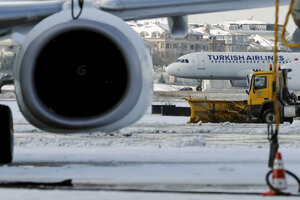2015 ranking of world's safest airlines: Has flying gotten safer?
An annual survey ranks 407 of the world's largest airlines as 2015 clocks another record-year for aviation safety.

A snow cutter cleans snow from the tarmac at Ataturk International airport in Istanbul, Turkey December 31, 2015.
Murad Sezer/AP/File
Statistically, flying is one of the safest ways to travel. But the combination of an aluminum tube, jet fuel, and a cruising altitude of 30,000 feet can give even frequent fliers pause when airline safety rankings come out.
An annual survey of the largest airlines put Australian-carrier Qantas on top for the third year in a row, the same number of years AirlineRatings.com, a product safety review board based in Australia, has issued its list.
AirlineRatings.com's rating system, which ranks airlines on a scale of 1 to 7 stars, considers audits from aviation's oversight authorities and governments, as well as participating airlines' fatality records, and operational histories. Of 407 surveyed, 148 were given the seven-star safety ranking, and almost 50 were awarded three stars or less. There are 10 airlines with only one star and these airlines are from Indonesia, Nepal, and Surinam.
While it may appear those airlines with fewer stars should be put on any consumer's no-fly list, keep in mind that no matter the airline, there are statistically nearly zero accidents per a million miles flown, according to accident data compiled by the US National Transportation Safety Board in 2008.
Since that data was published in 2008, flying has only gotten safer.
AirlineRatings.com says that even though there have been recent, high-profile accidents, 2015 was a safer year for aviation than the previous 12 months, making it one of the safest years for air travel since humans took flight. In 2015, the total of 16 major accidents with 560 fatalities was below the 10-year average of 31 accidents and 714 fatalities.
"Balancing these numbers, the world's airlines carried a record 3.6 billion passengers on 29 million flights in 2015," according to the ratings website.
"Flashback 50 years and there were a staggering 87 crashes killing 1,597 when airlines carried only 141 million passengers – 5% of today's number."
Put another way, as Physics.com reports, 2015 and many years preceding, were increasingly safer: the accident rate declined as more people opted to travel by air. Fatalities of one per 2.38 million flights made 2014 briefly the safest year ever, before it was bested by 2015, following one accident per 1.91 million flights in 2013, one per 2.37 million in 2012, one per 1.4 million in 2011 and one per 1.26 million in 2010.
With the safety of air travel in mind, the top 20 safest airlines in alphabetical order are: American Airlines, Alaska Airlines, All Nippon Airways, Air New Zealand; Cathay Pacific Airways, Emirates, Etihad Airways, EVA Air, Finnair, Hawaiian Airlines, Japan Airlines, KLM, Lufthansa, Qantas, Scandinavian Airline System, Singapore Airlines, Swiss, United Airlines, Virgin Atlantic, and Virgin Australia, according to AirlineRatings.com.

